Abstract
Experimental work on grounding systems has shown that the characteristics of grounding systems under high impulse conditions are different than those obtained at steady-state conditions. Investigations on the grounding systems under high impulse conditions make it evident that ionization process could occur in soil, due to field enhancement in air voids in the soil. This process can lead to an ionization zone that reduces the impulse resistance of grounding systems (due to an enlargement of a virtually increased cross-sectional area) from its steady state. There have been many studies pointing towards the effect of various soils and the ground electrode’s arrangement on the reduction of impulse resistance from its steady state, and its decrease with increasing currents. It was, however, noted that very few studies on the effect of the configurations of horizontal ground electrodes have been performed by field measurements before. This work presents the experimental and simulated work of various configurations of ground electrodes, with spikes which are thought to enhance the ionization process in soil. In this paper, field measurement was set up, and the results of field measurements were applied with finite element method (FEM) to obtain the electric field values. It was demonstrated that with the addition of spike on the electrodes, a high electric field was computed. The time to peak current, discharged time and impulse impedance were also analyzed for various horizontal ground electrodes.
1. Introduction
Grounding systems are needed for any electrical installation to discharge high current to the ground effectively. An established knowledge of the soil ionization process, which could occur during the discharge of a high impulse current to the ground, has been in place for almost a century [1,2,3,4,5]. This ionization process provides the improved performance of grounding systems, where a reduction of impulse ground impedance is observed. Factors determining the degree of reduction of impulse ground resistance, among which are impulse current magnitudes, soil resistivity, ground resistance value at steady state, or resistance of direct current, RDC and impulse polarity, have also been demonstrated by several researchers [1,2,3,4,5,6]. Generally, it was observed in these publications [1,2,3,4,5,6] that, the higher the current magnitudes, the lower the impulse ground impedance values are. Many studies [3,6] have also demonstrated that, under a high impulse current, a smaller reduction of impulse impedance was observed for the grounding systems’ low RDC. While the impulse polarity effect has been known to affect the breakdown voltage and performance of dielectric materials [7,8], an obvious noticeable impulse polarity effect was also found to occur for some soil conditions, when grounding systems are subjected to an impulse current [2,3,6]; it was observed that with positive impulse polarity, lower impulse impedance values were noticed for some ground electrodes. Many other factors have been discovered from experimental and analytical expressions that have shown differences in the degree of the ionization process, or the percentage of the decrease in the ground impedance from its RDC. It has been highlighted in [4,5] that the percentage of the decrease in the ground impedance from its RDC would be important in predicting the lightning performance accurately and in obtaining an optimized design of grounding systems for many electrical installations. In [4,5], mathematical expressions consider the extended electrodes that are presented to provide a more accurate estimation of the degree of the decrease in impulse impedance from its RDC for various ground electrode designs. They [4,5] estimated the impulse impedance in Ω, Zimp, from the characteristic dimension of the electrode in m, S, the impulse current in A, I, the critical soil ionization strength in V/m, Ec of an electrode. As for the value of Ec, the values can be obtained experimentally, or by adjusting the Ec until the Zimp obtained theoretically is achieved. This relation can also be seen in Equation (1), defined in [4], where Ig is the ground current, Ec is the critical electric field, ρ is the soil resistivity, and R is the resistance at a steady state.
Despite the fact that many studies [1,2,3,4,5,6] have been presented towards the soil ionization process that could occur when grounding systems are under high impulse currents, improvement in the design of ground electrodes that considers an ionization process in soil is still found to be limited. This paper presents the new design of ground electrodes, which consider an ionization process in soil. As early as 1948, Petropoulos [3] demonstrated by laboratory tests that with an attachment of spike rods to the spherical electrodes, lower breakdown voltage and lower reduction of impulse impedance was observed, in comparison to the spherical electrode without the spike rods. His study [3] gives an indication that a better performance of grounding systems under impulse conditions can be achieved when the ground electrodes with sharp spike rods and non-uniformity of electric field is being considered.
However, there have been limited designs that can be found in the literature, nor patent, towards the design of ground electrodes in improving the performance of grounding systems when subjected to impulse conditions, without compromising the required ground resistance value, RDC. For the performance of grounding systems subjected to high impulse conditions, it can be noticed from Equation (1) that the lower the RDC, the lower the Ec. This can result in a lesser percentage of the decrease in the impulse impedance in relation to RDC. Similarly, from Equation (1), it can be seen that the low soil resistivity gives a low Ig, and a higher critical electric field, Ec, is required to cause ionization in soil.
The work in determining whether there is a need to develop new designs of ground electrodes and to provide comparative analysis to conventional electrodes is still considerably limited. For that reason, this paper presents the experimental and finite element method (FEM) results of two new designs of ground electrodes, namely spiked strip ground electrode and linear array, and compares them with the conventional strip electrode.
2. Experimental and Simulation Arrangement
2.1. Tested Ground Electrodes and Remote Ground Electrodes
Figure 1 and Figure 2, respectively, show the spiked strip ground electrodes and the linear array used in this study. For the spiked strip ground electrode, it is similar to the patent filed in [9], with a shaft that faces downward and a cylindrical configuration, with a diameter of 20 mm and a 50 mm length. The strip conductor has a width of 40 mm and is 2 mm thick, connected to the shaft by bolts and nuts, with the connector plate, of a 50 mm length, 40 mm width and 3 mm thickness. At the end of the shaft, the shape is of a pointed spike, with 100 mm depth and a base of a 20 mm diameter with an angle of 45o. The gap from one shaft to another is 150 mm apart. The shaft is buried facing downward to provide a more effective dissipation of the current into the grounding systems.
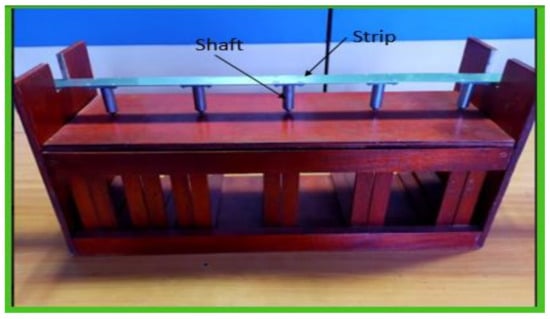
Figure 1.
Spiked strip ground electrodes.
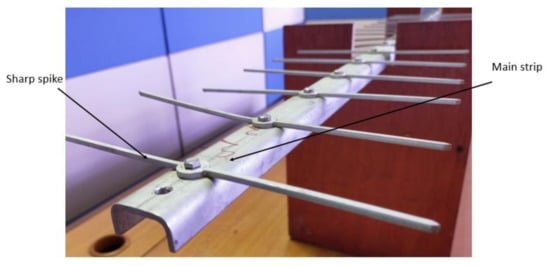
Figure 2.
Linear array ground electrodes.
For the linear array electrode, the main strip conductor is of the same size as the spiked strip ground electrode. A sharp spike, with a length of 200 mm and thickness of 5 mm is bolted to the main strip with bolts and nuts. The sharp spikes are separated from each other by 70 mm. Both the spiked strip ground and linear array electrodes are made of a non-magnetic stainless steel. A conventional strip electrode, made of copper, with the thickness of approximately 6 mm and a width of 20 mm was also used, where the results of all the electrodes are compared. All of these three electrodes have a length of 1.5 m. The same trench was used for the installation of all electrodes, but with the presence of the shaft in the spiked strip, and the sharp spike in the linear array. The cross-sectional area of the trench is expected to be different for all electrodes. The length and width of the trench, respectively, are: 1.5 m and 200 mm for conventional electrodes, while the area of the spiked strip electrode is found by taking the conventional electrode added to the area of the trench (0.05 m depth of shaft × 1.5 m × 2 (for each side of the trench)). As for the linear array electrode, exposed soil area A includes the bottom of the trench in Figure 3, as well as the sides and ends. This extra area is roughly 0.2 m width × 1.5 m length larger than the area for conventional strip, added to the extra exposed area at both ends (0.05 mm × 2 (two sides)). An example of the linear array’s installation in the trench can be seen in Figure 3, and the calculations are detailed in Table 1.
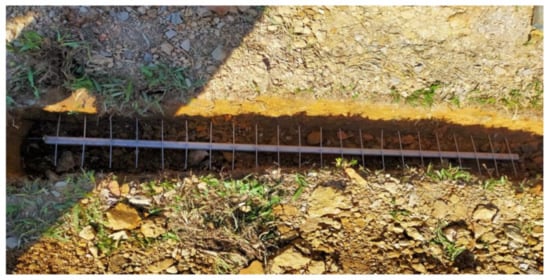
Figure 3.
Installation of the linear array ground electrode in the trench.

Table 1.
Values of the parameters used for various electrodes for RDC calculation.
Another ground electrode is a remote earth, which is needed to discharge any unexpected high currents through the ground terminal of impulse generator. In this study, a common remote earth was used to test all of these electrodes, which consists of a rectangular grid with 20 m × 30 m conventional horizontal copper strips exothermically welded to 12 rod electrodes, each of which have a diameter of 160 mm and are 1800 mm in length. These electrodes are at 300 mm below the ground’s surface. The fall-of-potential (FoP) method was applied to measure the RDC of all these electrodes, which found to be 82.9 Ω, 72.7 Ω and 101.9 Ω, respectively, for the spiked strip, linear array and conventional electrodes.
2.2. Testing Sites
The plan view of the field site testing is shown in Figure 4. All of these electrodes were buried at the same trench, and the heaped soil was used to backfill the trench after placing the electrodes in the trench. The impulse generator used in the study consists of three stages, where each stage can generate up to 100 kV. The impulse voltage measurement was obtained with a resistive divider, and the current measurements were achieved with a current transformer (CT). Remote earth of a rectangular grid was located more than 40 m away from the test electrode. Digital storage oscilloscopes (DSOs) are used to capture the voltage and current readings. Soil resistivity was obtained by using the Wenner method and interpreted into the upper and lower layer soils, using a current distribution, electromagnetic fields, grounding and soil structure analysis (CDEGS) software. The upper layer of the soil was found to have a soil resistivity, ρ1 of 160.20 Ωm, while the lower layer was found to have a soil resistivity, ρ2 of 359.63 Ωm. The former had ae thickness of 4.3 m, while the latter had an infinite thickness.
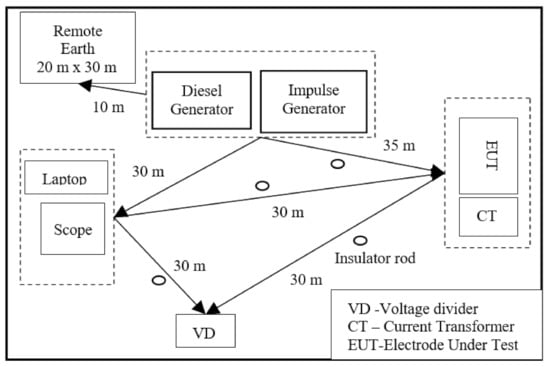
Figure 4.
Plan view of the testing at field site.
Due to the height of 4.3 m of the upper layer, it was realized from the arrangement of these horizontal electrodes that all of these electrodes were in contact with the upper layer only. Thus, to improve the confidence level in the measured results of RDC, presented in Section 2.1, RDC values were calculated for all electrodes using the geometric and contact resistance equations presented in [10]. In these equations, only the effective upper layer was used to calculate for contact resistance, Rc in Equation (2) and added to the geometric resistance, Rg in Equation (3) to obtain the total measured resistance, RDC, where the ρ1 is the upper soil resistivity in Ωm, defined as 160.2 Ωm for the calculation of all electrodes. L is electrode’s length in m, A is the cross-sectional area of the trench (π × length of the trench × width of the trench), in m2, Awire is the electrode’s cross-sectional area (2 × thickness × length of the electrode) in m2, g is the geometric sum of electrode radius rxyz in each direction from the center in m, defined in Equation (4). Table 1 lists the values defined for all parameters, for all three electrodes. It was observed from the table that the percentage difference was below a 10% difference for all electrodes, verifying and confirming both the measurement and calculation methods. This analysis also shows that for the electrodes installed at the upper layer, the formula from Conseil International des Grands Réseaux Électriques (CIGRE) [10] can be used and considered as highly correct, where only the soil resistivity of upper layer should be considered in the calculation. It was believed that the complexity of the configurations and geometries of the spiked strip and linear arrays contributed to slightly higher percentage differences between the measured and calculated values of RDC, in comparison to a direct forward geometry of the conventional electrode.
2.3. FEM Simulation
In this simulation, the ground electrode configurations and details are first defined by using quasi-static conditions. Using the soil resistivity values obtained from the site, presented in an earlier section, the values are placed in the simulation. An AC/DC module was utilized to compute the electric field, current, and potential distributions of the grounding electrodes, in the same trench/field site. The first part of the simulation is to construct the 3-D geometry and define the boundary size of the ground electrodes. At this stage, the types of materials and its conductivity values are defined. Figure 5 shows the 3-D model of the ground electrodes, where a boundary size of 40 m × 40 m was used for all ground electrodes. It was noticed that little difference was seen when the boundary size was changed from 10 m × 10 m to 50 m × 50 m. Table 2 provides information on the voltage values as the boundary changes, which was found to be close when the boundary size was changed from 10 m to 50 m. For this reason, the same size of 40 m × 40 m was used as the boundary size to simulate the electric field profiles of all ground electrodes. It needs to be highlighted here that the same trench was used throughout the tests, thus a similar boundary size can be considered. The same magnitude of 100 kV was applied for all electrodes, the results of which are discussed in Section 3. The ground electrodes in Figure 5, are modeled and constructed in FEM and are shown in Figure 6, Figure 7 and Figure 8, respectively, for the spiked strip, linear array and conventional ground electrodes.
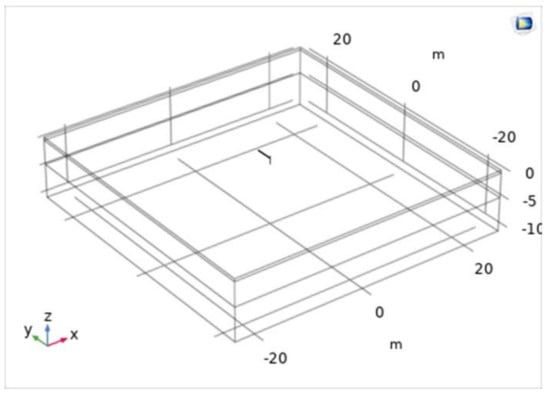
Figure 5.
3-D model of the ground electrodes.

Table 2.
Integral line from point of injection to boundary.
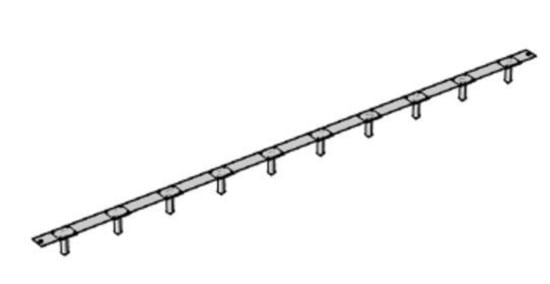
Figure 6.
Model of the tested spiked strip ground electrode.
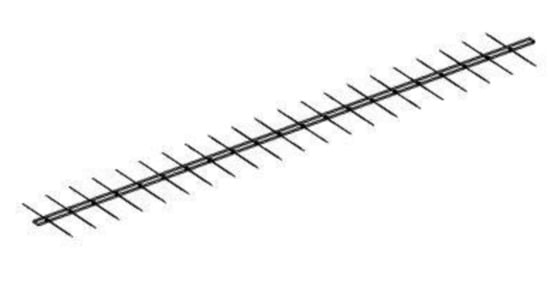
Figure 7.
Model of the tested linear array ground electrode.
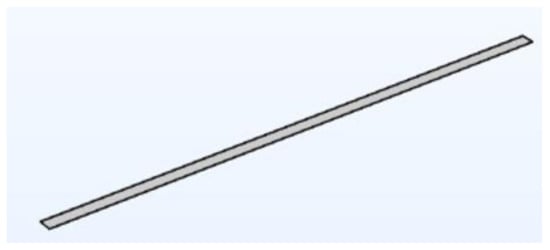
Figure 8.
Model of tested conventional ground electrode.
3. Experimental and Simulated Results
3.1. Experimental Test Results
Figure 9 shows the traces of the voltage and current for the spiked strip ground electrodes at 100 kV of charging voltage. For other configurations, and at other voltage levels, traces are found to be similar to Figure 9. Little difference is noted in terms of peak current, discharged times and impulse impedance values for all three electrodes, which are respectively shown in Figure 10, Figure 11 and Figure 12, which could be due to low RDC, and referring to Equation (1), other parameters (i.e., Ec, ρ, Ig) could become of a similar range. Another reason that may contribute to similar characteristics for all these ground electrodes, though they have significant differences in their electric field profiles, which will be presented in the next sub section, could be low soil resistivity, which has become a dominant factor in the measurements, making the electrode’s configurations less significant. The characteristics of these electrodes, where the discharged times and impulse impedance decrease with increasing currents, indicate a better conduction that can be associated with the ionization process at higher magnitudes of current. It was also noticed from the experimental work that the linear array electrode has the lowest impulse impedance, as shown in Figure 9, which could be due to its low RDC and high electric field values obtained from FEM, presented in the next section.
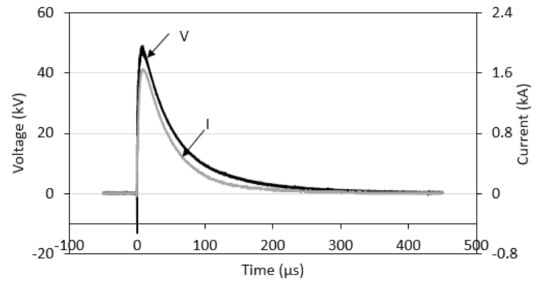
Figure 9.
Voltage and current traces for spiked strip ground electrode at 100 kV.
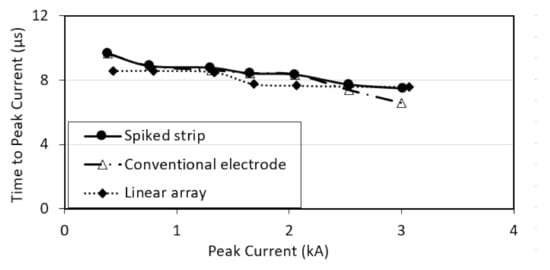
Figure 10.
Time to peak current vs. peak current for all configurations.
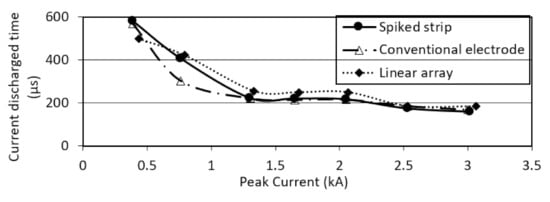
Figure 11.
Current discharged time vs. peak current for all configurations.
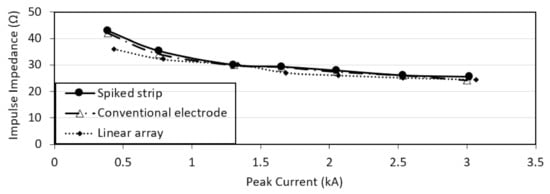
Figure 12.
Impulse impedance vs. peak current for all configurations.
3.2. FEM Simulation Results
Figure 13, Figure 14 and Figure 15, respectively, show the potential contours for the spiked strip, linear array and conventional electrodes. As can be seen in the figures, non-uniformity of the electric fields is seen at sharp points at the shaft of the spiked strip conductor and the spike of linear array, labelled as areas ”a”, ”b”, ”c” and ”d”, whereas a rather uniform contour was seen for the conventional horizontal electrode. These contours are enlarged where the electric field at these areas are plotted in Figure 16, Figure 17 and Figure 18, respectively, for the spiked strip, linear array and conventional electrodes. As can be seen for both the spiked strip and linear array, the highest electric field values are noticed at the sharp points, where the maximum electric field for the spiked strip is at area ”a” with a value of 12,000 kV/m at the pointed end of the shaft, followed by ”b” and ”c” of 3100 kV/m and as expected, the smaller electric field is at ”d”, averaging to 2200 kV/m due to a smoother surface of the main strip, in comparison to ”a”, ”b” and ”c”’. For the linear array, similar observations were seen, where the highest electric field was noted for the sharp pointed area, where in this case, it is at ”a” for the sharp spike, with an electric field of 60,000 kV/m. It was also noticed from Figure 17 that high electric field remains in most regions of the electrodes, particularly around the sharp spikes in the linear array electrode.
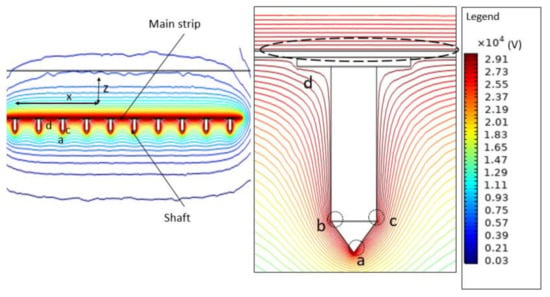
Figure 13.
Potential contour of the spiked strip ground electrode.
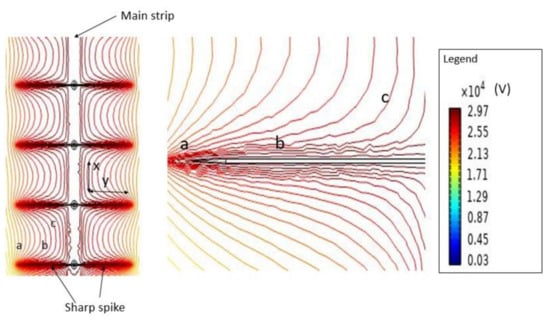
Figure 14.
Potential contour of the linear array ground electrode.
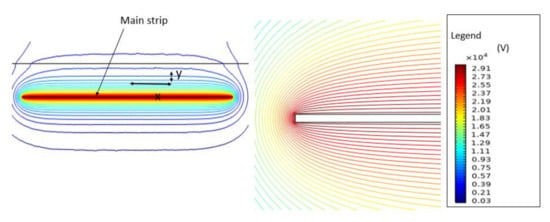
Figure 15.
Potential contour of the conventional ground electrode.
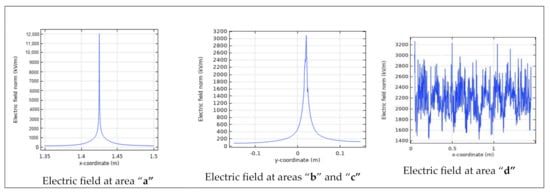
Figure 16.
Electric field values at corresponding areas of “a”, “b”, “c” and “d” of the spiked strip ground electrode, shown in Figure 13.
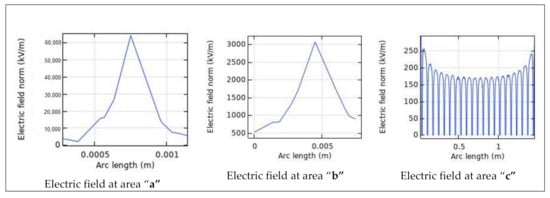
Figure 17.
Electric field values at corresponding areas of “a”, “b” and“c” of the linear array ground electrode, shown in Figure 14.
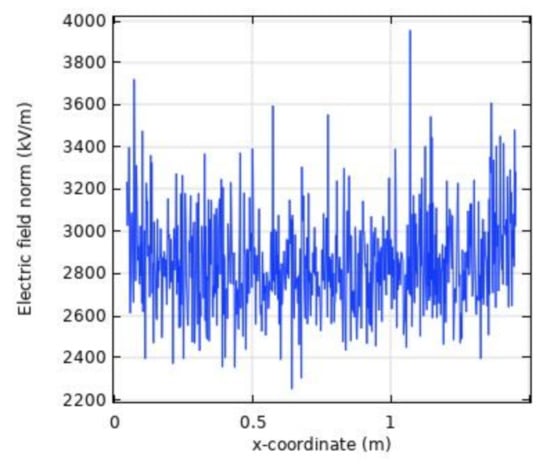
Figure 18.
Electric field values of the conventional ground electrode.
On the other hand, expectedly, for the conventional electrode, the smaller electric field value averaging at 3000 kV/m is noted (see Figure 18), since there are no sharp points, nor non-uniformity in the design. This is the range of value of the air breakdown, which is a considerably smaller value, to cause ionization in the soil. The comparison between the electric field values of the flat area of the conventional strip with the flat area of the linear array and spiked strip labelled as ”b” for the linear array and ”d” for the spiked strip, could be due to the copper material used in conventional electrodes, which has better conductivity, as set in FEM, in comparison to the stainless steel material used for the spiked strip and linear array electrodes.
4. Conclusions
In this study, experimental and simulation work was carried out on three ground electrodes: a spiked strip ground electrode, linear array electrode and conventional horizontal electrode. Calculated RDC values for all three electrodes were firstly performed and compared with the measured RDC. Close results were seen for the calculated and measured RDC, confirming each other’s method. It was observed that for the experimental work, little variation was seen in terms of the time to peak current, current discharged time and impulse impedance values for all three electrodes, which could be due to the low RDC, and the results are influenced by the soil resistivity, rather than the configuration of the ground electrodes. The current discharged times and impulse impedance were found to decrease with increasing magnitudes of current for all electrodes, indicating a better conduction at higher current levels.
FEM was utilized and simulated for all electrodes, and it was observed that the highest electric field values are at the areas with sharp points/edges of the electrode. The highest electric values appeared for the spike in linear array, which was found to be five times higher than the highest electric field computed for the sharp points in spiked strip.
Though close experimental results are seen in the time to peak current, current discharged time, and impulse impedance for all electrodes, which could be due the low RDC used in the work, the simulated results suggest that the new design of ground electrode can still be considered, considering the right geometry and electrode configuration, particularly by having sharp edges, which can enhance ionization process, hence provide better conduction in soil.
Author Contributions
H.H.H.-D., N.F.I., N.M.N. and N.N.A. were involved in setting up the experiment, H.H.H.-D. and N.M.N. sorted out the data, H.H.H.-D. prepared the draft and N.M.N. helped with the validation of the analysis. A.M. and N.N.A. helped in securing the funding. All authors have read and agreed to the published version of the manuscript.
Funding
This research was funded by TELEKOM MALAYSIA RESEARCH AND DEVELOPMENT (TMR&D), grant number MMUE180027 and MMUE190085.
Institutional Review Board Statement
Not applicable.
Informed Consent Statement
Not applicable.
Conflicts of Interest
The authors declare no conflict of interest.
References
- Bellaschi, L.P. Impulse and 60-Cycle Characteristics of Driven Grounds. Trans. Am. Inst. Electr. Eng. 1941, 60, 123–128. [Google Scholar] [CrossRef]
- Bellaschi, P.L.; Armington, R.E.; Snowden, A.E. Impulse and 60-Cycle Characteristics of Driven Grounds-II. Electr. Eng. 1942, 61, 349–363. [Google Scholar] [CrossRef]
- Petropoulos, G.M. The High-Voltage Characteristics of Earth Resistances. J. Inst. Electr. Eng. Part II Power Eng. 1948, 95, 172–174. [Google Scholar]
- Chisholm, W.A.; Janischewskyj, W. Lightning Surge Response of Ground Electrodes. IEEE Trans. Power Deliv. 1989, 4, 1329–1337. [Google Scholar] [CrossRef]
- Oettle, E.E. A New General Estimation Curve for Predicting the Impulse of Concentrated Earth Electrodes. IEEE Trans. Power Deliv. 1988, 3, 2020–2029. [Google Scholar] [CrossRef]
- Liew, A.C.; Darveniza, M. Dynamic Model of Impulse Characteristics of Concentrated Earths. Proc. IEE 1974, 121, 123–135. [Google Scholar] [CrossRef]
- Kuffel, E.; Zaengl, W.S.; Kuffel, J. High Voltage Engineering: Fundamentals; Butterworth-Heinemann: Oxford, UK, 2000. [Google Scholar]
- Meyer, H.K.; Mauseth, F.; Pedersen, A.; Ekeberg, J. Breakdown Mechanisms of Rod-Plane Air Gaps with a Dielectric Barrier Subject to Lightning Impulse Stress. IEEE Trans. Dielectr. Electr. Insul. 2018, 25, 1121–1127. [Google Scholar] [CrossRef]
- Telekom Malaysia Berhad and Multimedia University. Spiked Strip Ground Electrodes System. MALAYSIA—Patent Application No. Pl 2020003500, 6 July 2020.
- CIGRE 694: Ground Potential Rise at Overhead AC Transmission Line Structures during Power Frequency Faults, Working Grou, e-CIGRE.org, July 2017, B2.56.
Publisher’s Note: MDPI stays neutral with regard to jurisdictional claims in published maps and institutional affiliations. |
© 2021 by the authors. Licensee MDPI, Basel, Switzerland. This article is an open access article distributed under the terms and conditions of the Creative Commons Attribution (CC BY) license (http://creativecommons.org/licenses/by/4.0/).